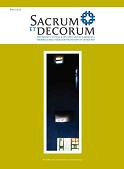Struktura argumentacji wczesnych interpretacji kaplicy w Ronchamp (część II)
The structure of argumentation in early interpretations of the Chapel at Ronchamp (Part II)
Author(s): Cezary WąsSubject(s): Cultural history
Published by: Wydawnictwo Uniwersytetu Rzeszowskiego
Keywords: Le Corbusier; Ronchamp; modern architecture; sacred architecture
Summary/Abstract: Contemporary reflections on the chapel at Ronchamp designed by Le Corbusier to a greater degree than before lead to analyses of previous interpretations of this work, arousing much controversy ever since their appearance. Research on the sources of his inspiration led to important discoveries, but entanglements of all descriptions in value systems, hidden assumptions, the structures of language and thought turn out to be no less interesting. Analyses undertaken in the present study concern five texts (the first two had been discussed in the previous issue of the “Sacrum et Decorum”), which appeared in the first few years after the building of the chapel. Statements made by the five authors, although chosen at random and only on the basis of their distinctive spaciousness and wealth of argumentation, revealed deep differences during their careful reading. Le Corbusier spoke on his behalf the most boldly and directly, not hiding his specific views, especially on the feeling of sacredness separate from the world of religion. Anton Henze attempted to make the work familiar by blurring the contradictions between Christianity and para-religious inclinations of the architect, present in his work. John Alford sought to describe the chapel with purified senses and mind but he could not go beyond language and its rules. It is only literary metaphors that enabled him to create a beautiful interpretation. Alois Fuchs saw in the building above all some forms of heresy, against which he wanted to protect the world of his religious values. His interpretation of the work on the hill developed in the direction of an official report on the rules of church art. Richard Biedrzynski wanted to avoid being buried in insoluble matters but only created a story showing the efficiency of the system which situated aesthetic values alongside cognitive and moral ones. The problem was that also this system created insoluble tensions and brought a lack of consent to the full separation of art from cognition and ethical issues. The author’s narrative, however, did not develop into a possible attempt to breach the coherence of the Kantian doctrine and turned into simple procedures for validating the earlier assumptions. The conclusions of the discussion of selected interpretations lead to the reflection on the impossibility of capturing the decisive statements about the chapel. Contrasting views of different authors were, after all, supported by satisfactory arguments, and cannot be dismissed even when they are mutually exclusive. However, there is a growing concern that the adopted and in a sense external point of describing selected accounts of the work just contains subsequent illusions and hidden assumptions that in the course of further research should be characterized as equally uncertain, like all the previous ones.
Journal: Sacrum et Decorum. Materiały i studia z historii sztuki sakralnej
- Issue Year: 2012
- Issue No: 5
- Page Range: 102-135
- Page Count: 34
- Language: Polish

